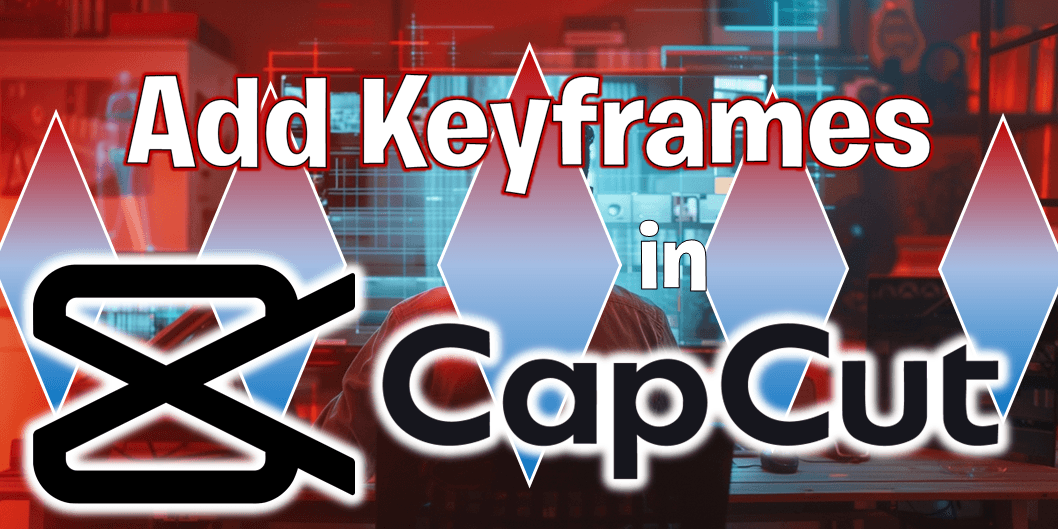How to Add Keyframes in CapCut: Beginner's Guide
Last UpdatedFebruary 18, 2024
by
Anthony Gallo

Similar to using the latest trending CapCut templates, adding keyframes in CapCut will take your video editing skills to another level.
By learning how to add keyframes in CapCut, you'll be able to make your own smooth animations and give yourself greater control overall over transitions and other visual effects.
In the guide, I'll show you exactly how to add keyframes in CapCut for mobile app and PC users, plus share some best practices for using keyframes.
What Are Keyframes in Video Editing?
Keyframes in video editing are points set at specific times in a clip that define the start and end of a transition or effect. These effects can include position changes, scale adjustments, rotation, opacity shifts, color alterations, filter applications, and many more.
Explain Keyframes Like I'm Five (ELI5)
Imagine you're drawing a flipbook cartoon of a bouncing ball.
Instead of drawing the ball on every page, you first draw it at the moment it starts bouncing, reaches the top, and hits the ground again.
These special drawings are like keyframes in animation or video editing.
They mark the important positions or moments of the ball (or anything else moving).
The computer can then fill in the missing drawings between these keyframes to make the ball move smoothly.
Simple right!?
How to Add Keyframes in CapCut Mobile App
Traditionally mobile apps haven't been the most user friendly attempt keyframe animation and other 'advanced' video editing techniques.
The good news it, CapCut have done an amazing job of making keyframe animation really easy in the mobile app! Let's learn. 👇
1. Start a New Project
Start a project in CapCut and select the video clip you want to edit.
2. Choose Your Clip
Select the video clip you want to add keyframes to by tapping it.
3. Add Your First Keyframe
Tap on the keyframe icon to initiate keyframe editing.
This action adds a first keyframe to your timeline, indicating the start of your animation.
You'll see a small red diamond where the keyframe has been added to your clip.
4. Add More Keyframes
Move to the point in your video where you want the keyframe animation to end or change.
Make adjustments to your video at this point, such as resizing or repositioning the frame.
The app will automatically add a new keyframe to mark the change. You'll see small diamond icons added when the new keyframe is.
That's it!
When you playback your video, you should see a smooth animation between the keyframes you've set.
How to Add Keyframes in CapCut PC App
Adding keyframes and doing keyframe animation in the CapCut PC app is intuitive and straightforward.
Follow these steps to add keyframes in CapCut on PC:
1. Create a New Project
Start by launching the CapCut application on your PC. Go to the main menu and choose to create a new project. This is where you'll add and edit your video content.
2. Import Your Asset
Add the media file you want to edit by importing it into your project. Drag and drop your video or image file into the timeline to start editing.
3. Select Your Video on the Timeline
Click on the video clip in your timeline to select it. This action should reveal a set of editing tools or options for your selected clip.
4. Access and Add Keyframes
Look for a diamond-shaped icon, which represents the keyframe feature, next to adjustment settings like scale, position, or rotation.
Click on the “Add Keyframe” button (the diamond icon) at the point in the timeline where you want the effect or change to begin. You'll see a keyframe appear in the timeline.
5. Make Adjustments
After adding a keyframe, adjust the setting (e.g., scale, position) to your desired start value.
Move the playhead forward to where you want the effect to change or end, add another keyframe, and then adjust the setting to the new value.
CapCut will interpolate the changes between your keyframes, creating a smooth transition.
6. Preview Your Video
Play your video to see the changes in real-time. You should observe the adjustments happening between the keyframes you've set.
7. Navigate Between Keyframes
Use the arrow buttons next to the keyframe icon to move back and forth between keyframes. This is useful for precisely editing or adjusting keyframe settings.
8. Delete Keyframes
If you need to delete a keyframe, simply select it and press the backspace or delete key on your keyboard. To undo a change press CTRL/CMD + z
9. Apply Keyframes to Other Effects or Settings
You can also apply keyframes to other adjustments, such as effects or masks. Just look for the “Add Keyframe” button next to the setting you wish to animate.
Tips for Working with Keyframes in CapCut
Working with keyframes in CapCut can enhance your video editing skills and enable you to produce professional-looking videos.
Here's some tips for mastering keyframe animation in CapCut, whether you're animating transitions, creating smooth movements, or improving the overall dynamic of your video clips:
- Start with a Plan: Before diving into keyframe animation, have a clear idea of what you want your animation to look like. Planning out your actions can make the process of setting keyframes much smoother.
- Understand Keyframe Basics: Remember that keyframes mark the start and end points of any animation. Keyframes on the video timeline are crucial for defining how video clips move, change size, rotate, or alter their properties over time.
- Use Them Wisely: A common mistake I see when people learn keyframes is the overuse of them! Use them sparingly and be careful not to take away from the message of your content with too many visuals.
- Use Keyframes for Smooth Transitions: To create smooth transitions between video clips, carefully place and adjust keyframes at the beginning and end of clips. This will give you control over how one clip fades into another or moves across the screen. You can also use CapCut's built in Slow Motion effects for some extra flair.
- Experiment with Effects: The CapCut online editor allows users to apply keyframe animations to a wide range of effects. Experimenting with these can add a layer of sophistication to your videos.
- Precision is Key: For precise animation movements, zoom in on your video timeline. This will allow you to place keyframes at the exact moments needed for a smooth transition or effect.
- Adjust Keyframe Values Carefully: When adding new keyframes, carefully adjust their values (such as position, size, rotation, etc.) to ensure that the animation flows as desired. Subtle changes can make a big difference in the final output.
- Learn to Navigate Keyframes Efficiently: Use the navigation buttons to move between keyframes easily. This allows for quicker editing and adjustments, ensuring each keyframe is set perfectly in your video timeline.
- Practice Keyframe Interpolation: Understand how CapCut interpolates (calculates the intermediate frames) between keyframes. It will help you predict and design more complex animations, giving your videos a more fluid and natural motion.
- Reuse Keyframes for Efficiency: If you create a particularly effective keyframe animation, consider saving the settings or applying them to other video clips within your project to maintain consistency and save time.
- Continuously Preview Your Work: Regularly preview your animations by playing back the affected segments. This allows you to catch and correct any errors or unnatural movements early in the editing process.
- Stay Organized: If your project includes a lot of keyframe animations, keeping your timeline organized is essential. Properly label your clips and keep track of where you've set keyframes to avoid confusion.
By utilizing these tips when working with keyframes in CapCut, you'll elevate your video editing projects, create smooth and professional videos, and fully harness the creative potential of keyframe animations.
Wrapping Up
Working with keyframes in CapCut is a relatively simple yet effective way to create stunning transitions and effects in your next video.
While keyframes are quite simple to use on the CapCut mobile app, accessing them on desktop will be easier when attempting to create advanced effects with CapCut.
CapCut has a decent selection of trending transitions straight out of the box, but for the editor looking to add a specific look and feel to your content, mastering transitions is for you! Happy Editing. 😎

Anthony Gallo
Anthony Gallo is the cofounder of ContentCreator.com and lead educator in the online course 14 Day Filmmaker, that has taught over 100,000 aspiring creators how to shoot & edit professional video content with PRO and SMARTPHONE cameras.
Having created content in a variety of industries including commercial advertising, weddings, music videos, and hundreds of youtube videos, Anthony has amassed over 50 million views online and is constantly looking for new and engaging ways to create content and help others master this amazing craft.